
|
 |

|
 |
Turning 75 gracefully - Guru Maya Rao talks about her passion, her life and journey through dance by Anitha Santhanam, Bangalore e-mail: anitha_santhanam@yahoo.com May 2, 2003 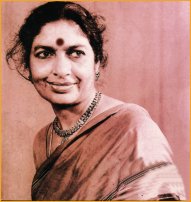 Kathak exponent, legendary choreographer and a much beloved dance guru Maya Rao (Maya Didi, as she is known to her students) turned 75 on May 2nd this year. In her illustrious career spanning over 50 years she has received many prestigious awards, choreographed ballets known for their visual artistry, authenticity and disciplined presentation and established the Natya Institute of Kathak and Choreography (NIKC), a one-of-its-kind institution offering graduate and post graduate courses in choreography. 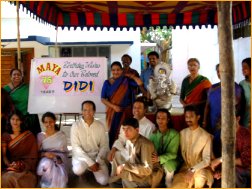 Both their beacon of light and steady anchor, Didi is cherished by her students for her caring and supportive nature, the freedom she gives them to innovate and learn and come into their own as dancers and choreographers. In her, professional excellence and goodness of heart come together to create a truly rare personality. In this interview she speaks about her passion, her students and her journey through dance. 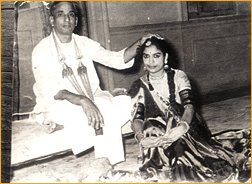
Maya Rao with Guru Shambhu Maharaj - 1956 You have seen Indian dance and dancers for over 50 years now. In all these years what has changed and what remains unchanged? Through the years the presentation has changed. In our time we did not focus so much on lighting, design etc. We tried to communicate everything through movement. Now most things are communicated through extraneous devices. The emphasis has shifted - presentation and publicity are overtaking content. The involvement of the audience is lesser now. The 'Sahrudaya' that Bharata talks about in the Natyashastra, the fervour in the audience has come down. Also there was less competition then. When we first went to a dance class we did not even think that we would perform on stage. But today on the first day of class, parents ask us when the children will make their stage debut? But what remains unchanged is the sincerity of 'good' dancers. Their commitment to do good work and perform well has not changed in all these years. The key word here is 'good' dancers, not all dancers. 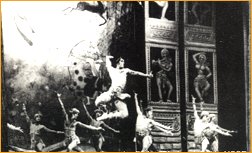
Dushyanta in a hunting sequence from the ballet "Shakuntalam" in USSR - Choreographed by Maya Rao - 1979 The term choreography is very much in focus these days. It's the favourite topic in dance seminars and workshops. Can you please tell us what it means exactly? The word choreography originated from Greek - 'Xoro' meaning dance and 'graph' meaning to write. In the Greek theatre, the audience was seated at very high elevation and dance appeared to them as if patterns were written on the floor through movement. Hence 'dance writing.' Through the centuries the term choreography has gained more connotations. Now it refers to the art of visualising an idea or a theme/story and presenting it on stage through dance but with a balanced combination of music, mime, and costume. This corresponds to the angika, vachika, satvika and aharya abinaya concept in the Natyashastra. Does the term apply only to group work or to solos as well? It applies to both. Choreography refers to a visual presentation of an idea - it could be through solo or group. In Michael Fokine's version of The Swan Lake he created the dance of the dying swan - a solo for Anna Pavlova. Uday Shankar did the dance of Indra as a solo. In Indian dance we have the Eka Patra Abinaya. 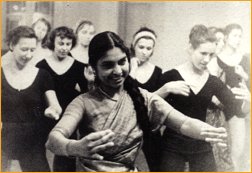
Maya Rao at the Theatre, Rega You are one of the legendary choreographers in India today. Were you attracted to choreography from the beginning or did it evolve through your performing career? I was attracted to choreography right from the beginning, even when I did not know much of dance technique. We used to put up Ramayana in college after reading Max Mueller's translation. I always loved directing, putting together dance dramas. You quit performing when you were in your early forties, at the peak of your career. Why? Well, due to some personal reasons I had to give up dancing for two years, when I was about 42. When I got back, I felt I had no right to dance since I had not practised for two years. During my performing years I used to spend a lot of time rehearsing. I felt I couldn't get back to the same form again. Now I see my dance through my students. It gives me great pleasure. You shouldn't keep dancing till you are tottering on stage, you know! Does good dancing lead to good choreography? Are all good dancers, good choreographers? Not necessarily. Sometimes good choreographers are not good dancers and vice versa. Some have the talent to compose and some to perform. When you perform, it's completely subjective, but when you choreograph you have to be objective, because you are presenting your idea, not yourself but through other dancers. So what makes for good choreography? First you have to be clear about what you want to say. And then you work on how to say it. This leads us to another important aspect - the interplay of form and content. In some choreography the technique becomes important, in some the theme itself. There is a huge divide in India between traditional dance and contemporary dance. Is this really necessary? No, it's not, because what's contemporary today, if it stands the test of time will become traditional to the next generations. The Kathak or Bharatanatyam that we see today has evolved quite a lot from the days it used to be danced in courts and temples. But to stand the test of time any dance should have substance and a solid base. It's felt that today's generation is not interested in Indian art - especially dance and music. Do you agree? No, I don't. It's this generation's parents who are not interested in dance and music. In my daughter Madhu's class there are children who wake up their parents to come and attend early morning Kathak classes. Also, it's the duty of the parents to inculcate an interest in Indian culture and art. NIKC is full of positive energies - friendliness, teamwork, innovation. It's obvious that you set out to establish a different kind of a training centre with some clear goals. Can you tell us what they are? That's right. During my early years as a dancer I struggled to get good training. So when I started NIKC I was very clear that it should give all the training and opportunity to students sincere about learning dance. They should not struggle like me. We really go out of the way to get exponents in different fields - mime, martial art, theatre design to come and take workshops here so our students get a solid base in all aspects of dance presentation. I was clear that NIKC should provide the right climate for their creativity to flourish. In fact, we have trained many students without taking any fee if we felt that they were talented and deserved the opportunity. Even today we help graduates support themselves, to get a foothold in dance. 75 years. It's been a long journey. How would you describe it? It has been a great journey so far. Lot of happiness. I have met many great artists, performers, writers, gurus, learnt more about the art. I enjoy the company of my students. My family stood by me - my husband Nataraj, my brothers, sisters-in-law, everybody. When I received the Shantala Award, I wanted all of them to come and take it. It was as much theirs as it was mine. Sometimes women quit dance saying they have too much family duty. It's never been like that for me. But I believe that women should make space for their own work also. The good times and the bad. How have they played out in your life? I have had my share of bad experiences. But at the end of the day, you remember the good and cherish it more. My love for dance kept me going through the tough times. While dancing, nothing else matters. There are always good people; they keep you going. |